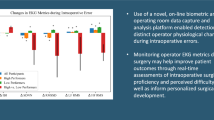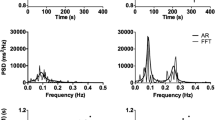Abstract
Most surgical procedures involve structures deeper than the skin. However, the difference in surgical noxious stimulation between skin incision and laparoscopic trocar insertion is unknown. By analyzing instantaneous heart rate (IHR) calculated from the electrocardiogram, in particular the transient bradycardia in response to surgical stimuli, this study investigates surgical noxious stimuli arising from skin incision and laparoscopic trocar insertion, and their difference. Thirty-five patients undergoing laparoscopic cholecystectomy were enrolled in this prospective observational study. Sequential surgical steps including umbilical skin incision (11 mm), umbilical trocar insertion (11 mm), xiphoid skin incision (5 mm), xiphoid trocar insertion (5 mm), subcostal skin incision (3 mm), and subcostal trocar insertion (3 mm) were investigated. IHR was derived from electrocardiography and calculated by the modern time-varying power spectrum. Similar to the classical heart rate variability analysis, the time-varying low frequency power (tvLF), time-varying high frequency power (tvHF), and tvLF-to-tvHF ratio (tvLHR) were calculated. Prediction probability (PK) analysis and global pointwise F-test were used to compare the statistical performance between indices and the heart rate readings from the patient monitor. Analysis of IHR showed that surgical stimulus elicits a transient bradycardia, followed by the increase of heart rate. Transient bradycardia is more significant in trocar insertion than skin incision (p < 0.001 for tvHF). The IHR change quantifies differential responses to different surgical intensity. Serial PK analysis demonstrates de-sensitization in skin incision, but not in laparoscopic trocar insertion. Quantitative indices present the transient bradycardia introduced by noxious stimulation. The results indicate different effects between skin incision and trocar insertion.




Similar content being viewed by others
References
Funcke S, Sauerlaender S, Pinnschmidt HO, et al. Validation of innovative techniques for monitoring nociception during general anesthesia: a clinical study using tetanic and intracutaneous electrical stimulation. Anesthesiology. 2017;127:272–83.
Gruenewald M, Ilies C, Herz J, et al. Influence of nociceptive stimulation on analgesia nociception index (ANI) during propofol-remifentanil anaesthesia. Br J Anaesth. 2013;110:1024–30.
Huiku M, Uutela K, van Gils M, et al. Assessment of surgical stress during general anaesthesia. Br J Anaesth. 2007;98:447–55.
Logier R, Jeanne M, Dassonneville A, Delecroix M, Tavernier B. PhysioDoloris: a monitoring device for analgesia/nociception balance evaluation using heart rate variability analysis. Conf Proc IEEE Eng Med Biol Soc. IEEE; 2010; 1194–1197.
Seitsonen ER, Korhonen IK, van Gils MJ, et al. EEG spectral entropy, heart rate, photoplethysmography and motor responses to skin incision during sevoflurane anaesthesia. Acta Anaesthesiol Scand. 2005;49:284–92.
Laitio RM, Kaskinoro K, Särkelä MO, et al. Bispectral index, entropy, and quantitative electroencephalogram during single-agent xenon anesthesia. Anesthesiology. 2008;108:63–70.
Ekman A, Brudin L, Sandin R. A comparison of bispectral index and rapidly extracted auditory evoked potentials index responses to noxious stimulation during sevoflurane anesthesia. Anesth Analg. 2004;99:1141–6.
Klockars JG, Hiller A, Münte S, van Gils MJ, Taivainen T. Spectral entropy as a measure of hypnosis and hypnotic drug effect of total intravenous anesthesia in children during slow induction and maintenance. Anesthesiology. 2012;116:340–51.
Zbinden AM, Petersen-Felix S, Thomson DA. Anesthetic depth defined using multiple noxious stimuli during isoflurane/oxygen anesthesia. II. Hemodynamic responses. Anesthesiology. 1994;80:261–7.
Rantanen M, Yppärilä-Wolters H, van Gils M, et al. Tetanic stimulus of ulnar nerve as a predictor of heart rate response to skin incision in propofol remifentanil anaesthesia. Br J Anaesth. 2007;99:509–13.
Pogatzki-Zahn EM, Wagner C, Meinhardt-Renner A, et al. Coding of incisional pain in the brain: a functional magnetic resonance imaging study in human volunteers. Anesthesiology. 2010;112:406–17.
Feinstein B, Langton JN, Jameson RM, Schiller F. Experiments on pain referred from deep somatic tissues. J Bone Joint Surg Am. 1954;36:981–97.
Graven-Nielsen T. Fundamentals of muscle pain, referred pain, and deep tissue hyperalgesia. Scand J Rheumatol Suppl. 2006;122:1–43.
Hall JE. Somatic Sensations: II. Pain, Headache, and Thermal Sensations. In: Hall JE, editor. Guyton and Hall Textbook of Medical Physiology. 13th ed. Philadelphia: Saunders Elsevier; 2015. p. 621–32.
Lin YT, Wu HT. ConceFT for time-varying heart rate variability analysis as a measure of noxious stimulation during general anesthesia. IEEE Trans Biomed Eng. 2017;64:145–54.
Daubechies I, Wang YG, Wu HT. ConceFT: concentration of frequency and time via a multitapered synchrosqueezed transform. Phil Trans A Math Phys Eng Sci. 2016;374:20150193.
Lin YT, Wu HT, Tsao J, Yien HW, Hseu SS. Time-varying spectral analysis revealing differential effects of sevoflurane anaesthesia: non-rhythmic-to-rhythmic ratio. Acta Anaesthesiol Scand. 2014;58:157–67.
Lin YT, Flandrin P, Wu HT. When Interpolation-Induced Reflection Artifact Meets Time-Frequency Analysis. IEEE Trans Biomed Eng. 2016;63:2133–41.
Task Force of the European Society of Cardiology. Heart rate variability, standards of measurement, physiological interpretation, and clinical use. Circulation. 1996;93:1043–65.
Smith WD, Dutton RC, Smith TN. Measuring the performance of anesthetic depth indicators. Anesthesiology. 1996;84:38–51.
Zhang JT, Liang X. One-way ANOVA for functional data via globalizing the pointwise F-test. Scand J Stat. 2014;41:51–71.
Brignole M, Menozzi C, Bottoni N, et al. Mechanisms of syncope caused by transient bradycardia and the diagnostic value of electrophysiolopic testing and cardiovascular reflexivity maneuvers. Am J Cardiol. 1995;76:273–8.
Porges SW. The polyvagal perspective. Biol Psychol. 2007;74:116–43.
Kosaka M, Asamura SI, Kamiishi H. Oculocardiac reflex induced by zygomatic fracture; a case report. J Craniomaxillofac Surg. 2000;28:106–9.
Hahnenkamp K, Hönemann CW, Fischer LG, Durieux ME, Muehlendyck H, Braun U. Effect of different anaesthetic regimes on the oculocardiac reflex during paediatric strabismus surgery. Paediatr Anaesth. 2000;10:601–8.
Brantley JC 3rd, Riley PM. Cardiovascular collapse during laparoscopy: a report of two cases. Am J Obstet Gynecol. 1988;159:735–7.
Boscan P, Paton JF. Role of the solitary tract nucleus in mediating nociceptive evoked cardiorespiratory responses. Auton Neurosci. 2001;86:170–82.
Paton JF, Nalivaiko E, Boscan P, Pickering AE. Reflexly evoked coactivation of cardiac vagal and sympathetic motor outflows: observations and functional implications. Clin Exp Pharmacol Physiol. 2006;33:1245–50.
American National Standard: Requirement. In: American National Standard. Cardiac monitors, heart rate meters, and alarms, ANSI/AAMI EC13:2002/(R)2007, 2007; 7–13.
Keay KA, Clement CI, Owler B, Depaulis A, Bandler R. Convergence of deep somatic and visceral nociceptive information onto a discrete ventrolateral midbrain periaqueductal gray region. Neuroscience. 1994;61:727–32.
Keay KA, Crowfoot LJ, Floyd NS, Henderson LA, Christie MJ, Bandler R. Cardiovascular effects of microinjections of opioid agonists into the depressor region of the ventrolateral periaqueductal gray region. Brain Res. 1997;762:61–71.
Behbehani MM. Functional characteristics of the midbrain periaqueductal gray. Prog Neurobiol. 1995;46:575–605.
Morgan MM, Whitney PK, Gold MS. Immobility and flight associated with antinociception produced by activation of the ventral and lateral/dorsal regions of the rat periaqueductal gray. Brain Res. 1998;804:159–66.
Henderson LA, Keay KA, Bandler R. The ventrolateral periaqueductal gray projects to caudal brainstem depressor regions: a functional-anatomical and physiological study. Neuroscience. 1998;82:201–21.
Strigo IA, Duncan GH, Boivin M, Bushnell MC. Differentiation of visceral and cutaneous pain in the human brain. J Neurophysiol. 2003;89:3294–303.
Green AL, Paterson DJ. Identification of neurocircuitry controlling cardiovascular function in humans using functional neurosurgery: implications for exercise control. Exp Physiol. 2008;93:1022–8.
Funding
The work of C.-H. Chang was supported by the institutional research Grant (No. SKH-8302-105-DR-20) from Shin Kong Wu Ho-Su Memorial Hospital, Taipei, Taiwan. The work of Y.-T. Lin was supported by the National Science and Technology Development Fund (Grant No. MOST 106-2115-M-075-001) of Ministry of Science and Technology, Taipei, Taiwan.
Author information
Authors and Affiliations
Corresponding author
Ethics declarations
Conflict of interest
The authors declare that they have no conflict of interest.
Additional information
Publisher's Note
Springer Nature remains neutral with regard to jurisdictional claims in published maps and institutional affiliations.
Rights and permissions
About this article
Cite this article
Chang, CH., Fang, YL., Wang, YJ. et al. Differentiation of skin incision and laparoscopic trocar insertion via quantifying transient bradycardia measured by electrocardiogram. J Clin Monit Comput 34, 753–762 (2020). https://doi.org/10.1007/s10877-019-00378-w
Received:
Accepted:
Published:
Issue Date:
DOI: https://doi.org/10.1007/s10877-019-00378-w




